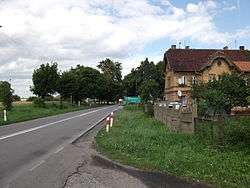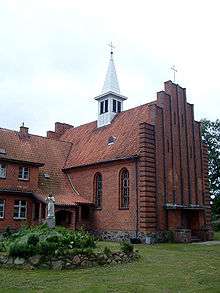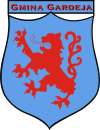Gardeja
| Gardeja | |
|---|---|
| Village | |
 | |
 Gardeja | |
| Coordinates: 53°36′26″N 18°56′28″E / 53.60722°N 18.94111°E | |
| Country |
|
| Voivodeship | Pomeranian |
| County | Kwidzyn |
| Gmina | Gardeja |
| Population | 2,500 |
Gardeja [ɡarˈdɛja] (formerly German Garnsee) is a village in Kwidzyn County, Pomeranian Voivodeship, in northern Poland. It is the seat of the gmina (administrative district) called Gmina Gardeja.[1]
Garnsee had been a town during the time span 1334–1945 and lost city rights after World War II, when it became part of Poland.
Geographical location
Gardeja lies approximately 15 kilometres (9 mi) south of Kwidzyn and 87 km (54 mi) south of the regional capital of Gdańsk. The village is located between two little lakes on the road from Kwidzyn to Grudziądz.

History
The village of Garnsee is mentioned in a document of 1323. A little while later, on October 4, 1334, the town of Garnsee was founded in the immediate vicinity of the village by Bertold von Riesenburg, Bishop of Pomesania; it was called Garzanum in the document of foundation.[2]
The main road of the settlement broadens toward its southern part to end up in the market place, at the south-eastern edge of which the church is located, probably first built around 1330–40. In 1527 the church became evangelical; its nave has been rebuilt in 1729–31. During the 19th century lectures were held in the church in German as well as in Polish language.[3]
After the town had burnt down in 1554, it was re-founded in 1559. In 1736 and 1759 it burnt down again, with the exception of a few houses. Around 1789 the town had 104 households, and its citizens lived mainly from agriculture, brewing and handicraft. In the 19th century it was the site of a local court and of a county court.
After World War I and the Treaty of Versailles a referendum was held allowing the inhabitants to decide on the future national membership of their town. As a result, it became part of Germany, although the town had to pass on its train station, which was located ten kilometers further south, to Poland. Garnsee now had become a border town. In 1927 a new train station was built.
Until 1919 Garnsee had belonged to Kreis Marienwerder in the administrative district of Regierungsbezirk Marienwerder in the province of West Prussia, from 1919 to 1939 in Regierungsbezirk Westpreußen of the province of East Prussia and from October 26, 1939, to 1945 in Regierungsbezirk Marienwerder of the province of Reichsgau Danzig-West Prussia.
During World War II Garnsee was captured by the Red Army. After the end of war the town became part of Poland under the Polish name Gardeja. Gardeja, which lost city rights under Polish administration, is sub-divided into four sołectwos: Gardeja I, II, III and IV.
In 2006 the village had a population of 2,500.
Number of inhabitants by year
| Year | Number |
|---|---|
| 1740 | 379 |
| 1788 | 457[3] |
| 1831 | 900[4] |
| 1885 | 1,205[5] |
| 1900 | 1,100[6] |
| 1905 | 984 |
| 1925 | 1,070[7] |
| 1933 | 2,062[5] |
| 1939 | 1,998[5] |
| 1943 | 2,196 |
| 2006 | 2,500 |
References
- ↑ "Central Statistical Office (GUS) - TERYT (National Register of Territorial Land Apportionment Journal)" (in Polish). 2008-06-01.
- ↑ Jacobson: Beitrag zur Geschichte der Preußischen Klöster – Über die Klöster des Cistercienserordens, in: Neues allgemeines Archiv für die Geschichtskunde des preußischen Staates (Leopold von Ledebur, ed.), Vol 2, Berlin Posen Bromberg 1836, pp. 33–42, in particular p. 36.
- 1 2 Johann Friedrich Goldbeck: Vollständige Topographie des Königreichs Preußen. Teil II, Marienwerder 1789, p. 8, no. 3.
- ↑ August Eduard Preuß: Preußische Landes- und Volkskunde. Königsberg 1835, p. 440, no. 55.
- 1 2 3 Michael Rademacher: Deutsche Verwaltungsgeschichte Provinz Westpreußen, Kreis Marienwerder (2006).
- ↑ Meyers Großes Konversations-Lexikon, 6th edition, Vol. 7, Leipzig and Vienna 1907, p. 343
- ↑ Der Große Brockhaus, 15th edition, Vol. 6, Leipzig 1930, p. 778.
External links
| Wikimedia Commons has media related to Gardeja. |
Coordinates: 53°36′00″N 18°55′59″E / 53.600°N 18.933°E
